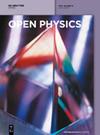通过达西多孔介质对非线性拉伸片上的 MHD 威廉姆森纳米流体流动进行数值分析:建模与模拟
IF 1.8
4区 物理与天体物理
Q2 PHYSICS, MULTIDISCIPLINARY
引用次数: 0
摘要
在当前的研究中,我们深入研究了纳米流体在威廉姆森边界层内的运动,重点分析了热量和质量传递(HMT)过程。这种特殊的流动发生在经历非线性拉伸的薄片上。这项研究的一个重要方面是在模型中加入磁场和粘性耗散的影响。薄片位于多孔介质中,该介质符合达西模型。由于还需要更精确的结果,该模型假定流体的导电性和粘度都会随温度变化。在这项研究中,我们遇到了一个极其非线性的常微分方程系统,该系统通过数值技术进行处理,特别是采用了谱配位法。使用图形表示法来说明相关参数如何影响纳米粒子的体积分数、速度和温度曲线。研究包括计算和分析物理参数对局部舍伍德数、皮肤摩擦系数和局部努塞尔特数的影响。本研究得出的具体重要发现突出表明,热泳系数、多孔参数和威廉姆森参数对传质速率的影响尤为明显,显示出更高的效应,而反之,布朗运动参数则显示出相反的模式。对结果进行了计算,并与之前的研究进行了比较,结果表明两者在很大程度上是一致的。本文章由计算机程序翻译,如有差异,请以英文原文为准。
Numerical analysis of the MHD Williamson nanofluid flow over a nonlinear stretching sheet through a Darcy porous medium: Modeling and simulation
In the current study, we delve into examining the movement of a nanofluid within a Williamson boundary layer, focusing on the analysis of heat and mass transfer (HMT) processes. This particular flow occurs over a sheet that undergoes nonlinear stretching. A significant facet of this investigation involves the incorporation of both the magnetic field and the influence of viscous dissipation within the model. The sheet is situated within a porous medium, and this medium conforms to the Darcy model. Since more precise outcomes are still required, the model assumes that both fluid conductivity and viscosity change with temperature. In this research, we encounter a system of extremely nonlinear ordinary differential equations that are treated through a numerical technique, specifically by employing the spectral collocation method. Graphical representations are used to illustrate how the relevant parameters impact the nanoparticle volume fraction, velocity, and temperature profiles. The study involves the computation and analysis of the effect of physical parameters on the local Sherwood number, skin friction coefficient, and local Nusselt number. Specific significant findings emerging from the present study highlight that the rate of mass transfer is particularly influenced by the thermophoresis factor, porous parameter, and Williamson parameter, showing heightened effects, while conversely, the Brownian motion parameter demonstrates an opposing pattern. The results were computed and subjected to a comparison with earlier research, indicating a notable degree of conformity and accord.
求助全文
通过发布文献求助,成功后即可免费获取论文全文。
去求助
来源期刊

Open Physics
PHYSICS, MULTIDISCIPLINARY-
CiteScore
3.20
自引率
5.30%
发文量
82
审稿时长
18 weeks
期刊介绍:
Open Physics is a peer-reviewed, open access, electronic journal devoted to the publication of fundamental research results in all fields of physics. The journal provides the readers with free, instant, and permanent access to all content worldwide; and the authors with extensive promotion of published articles, long-time preservation, language-correction services, no space constraints and immediate publication. Our standard policy requires each paper to be reviewed by at least two Referees and the peer-review process is single-blind.
 求助内容:
求助内容: 应助结果提醒方式:
应助结果提醒方式:


